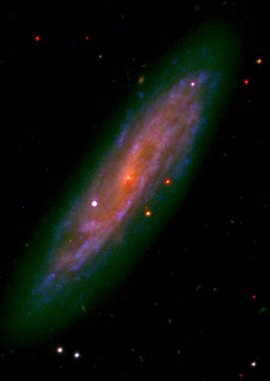7 March 2008
First Light For Binocular Telescope
by Kate Melville
 The Large Binocular Telescope (LBT) on Mount Graham, in Arizona, has captured images using its twin primary mirrors together for the first time, achieving first "binocular" light. First binocular light is a milestone not only for the LBT - now the world's most powerful telescope - but for astronomy itself, say the international group of partners in the project.
The Large Binocular Telescope (LBT) on Mount Graham, in Arizona, has captured images using its twin primary mirrors together for the first time, achieving first "binocular" light. First binocular light is a milestone not only for the LBT - now the world's most powerful telescope - but for astronomy itself, say the international group of partners in the project.
The image at right shows a three false-color rendition of the spiral galaxy NGC 2770. The galaxy is 102 million light years from our Milky Way. The image is a composite of ultraviolet, green and deep red light and shows the detailed structure of hot, moderate and cool stars in the galaxy.
The LBT has a light-collecting area equivalent to a single 11.8-meter (39-foot) surface and will combine light to produce the image sharpness equivalent to a single 22.8-meter (75-foot) telescope. "To have a fully functioning binocular telescope is not only a time for celebration here at LBT, but also for the entire astronomy community," said Observatory Director Peter A. Strittmatter. "The images that this telescope will produce will be like none seen before. The power and clarity of this machine is in a class of its own. It will provide unmatched ability to peer into history, seeing the birth of the universe."
Observatory Mirror Lab Director Roger Angel was one of the University of Arizona astronomers who conceived the basic idea for the LBT in the early 1980s. The UA Mirror Lab, world-renowned for pioneering mirror technologies, cast the LBT mirrors in its giant rotating furnace and polished them by a unique stressed-lap technique to virtual perfection. Angel was involved earlier in UA research that is developing adaptive optics technologies for giant telescopes, technologies that defeat atmospheric turbulence.
"Among astronomy projects, the LBT gives me the most satisfaction, because it is very revolutionary, and because it has given Arizona the largest and the best telescope in the world," Angel said. "When all the pieces are in place, the LBT will take images sharper than any other telescope. I think it's the most likely telescope to take the first pictures of planets around other stars because of the unique advanced technologies used to build it."
Related:
Polarization Technique Used To "See" Exoplanet
Balloon-Borne Solar Telescope Reaches 120,000 Feet
Exoplanet Imager Takes Shape
Source: University of Arizona
